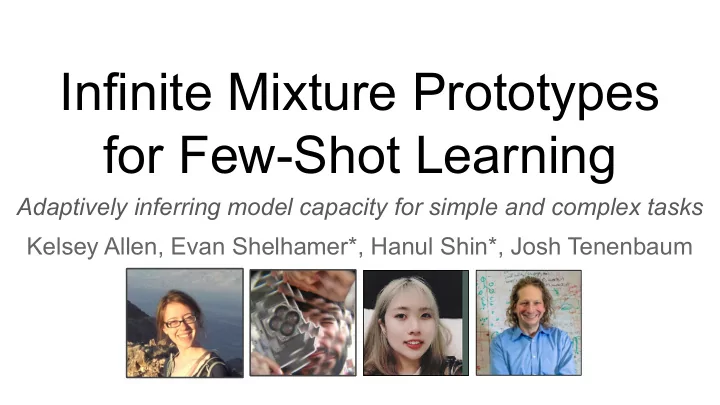

Infinite Mixture Prototypes for Few-Shot Learning Adaptively inferring model capacity for simple and complex tasks Kelsey Allen, Evan Shelhamer*, Hanul Shin*, Josh Tenenbaum
Few-Shot Learning by Deep Metric Learning Given few instances of a few classes, recognize a new instance: Labeled support Query
Few-Shot Learning by Deep Metric Learning Given few instances of a few classes, recognize a new instance: Labeled support Query deep net
Few-Shot Learning by Deep Metric Learning Given few instances of a few classes, recognize a new instance: Labeled support Query embedding embedding deep net
Few-Shot Learning by Deep Metric Learning Given few instances of a few classes, recognize a new instance: Unlabeled Labeled support support Query embedding embedding deep net
Few-Shot Learning by Deep Metric Learning Given few instances of a few classes, recognize a new instance: Unlabeled Labeled support support Query embedding embedding deep net deep net
Few-Shot Learning by Deep Metric Learning Given few instances of a few classes, recognize a new instance: Unlabeled Labeled support support Query embedding embedding deep net deep net
Simple and Complex Tasks ● Simple tasks might be accurately represented as uni-modal clusters ● Complex tasks might require a more sophisticated clustering ● A deeper/wider network may not solve both kinds of task simultaneously Omniglot super category task Omniglot character task
Simple and Complex Tasks ● Simple tasks might be accurately represented as uni-modal clusters ● Complex tasks might require a more sophisticated clustering ● A deeper/wider network may not solve both kinds of task simultaneously Omniglot character embeddings Omniglot super category embeddings
Infinite Mixture Modeling ● Represent clustering process using Dirichlet Process mixture model ● Unbounded number of clusters in mixture - let data determine for itself ● Naturally interpolates between nearest neighbors (each data point its own cluster) and prototypes (each cluster is uni-modal Gaussian) ● Semi-supervised and unsupervised possible
Adaptive Capacity for Simple and Complex Tasks ● Adapt between simple and complex data distributions by learning deep representation and inferring the number of clusters ● Efficient inference based on DP-means
Results Poster 87 - 25% absolute improvement over prototypical nets (Snell et al. 2017) for alphabet/super-class recognition on Omniglot - 10% absolute improvement for super-class to sub-class transfer on tiered-ImageNet - equal or better to fully-supervised and semi-supervised prototypical nets on Omniglot and mini-ImageNet benchmarks - 7% absolute improvement over deep nearest neighbors on mini-ImageNet - 20% absolute improvement in unsupervised clustering AMI
Recommend
More recommend